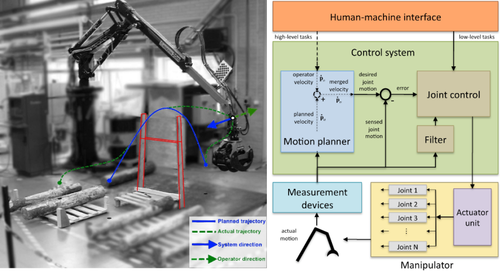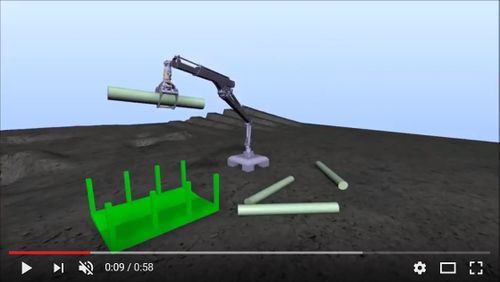Semi-Autonomous Crane
Industrial crane manipulators are widely used in mining, marine and forest environments. These are used for heavy and dangerous operations associated with the extraction, transport, and processing of raw materials and for various rescue operations. The electro-hydraulic and mechanical properties of large industrial manipulators make them difficult to control for both operators and using conventional control methods developed for industrial robots. Fast and stable motion control and semi-autonomous functions has emerged only recently in commercial systems. The lack of robust computer vision, however, severely limits the development of higher level autonomy, for example, ability to grip and move objects and to plan and predict the outcome of movements in unstructured environments.
We explore the use of computational modeling and multidomain dynamics with frictional contacts in the development of fully and semi-autonomous cranes. The research also address geometric design optimization of crane manipulators based on the computational model and simulation output.
Rigid multibody dynamics model Text to come
Motion planning and tracking Text to come
Co-simulation Text to come
Machine vision and perception The lack of robust computer vision, however, severely limits the development of higher level autonomy, for example, ability to grip and move objects and to plan and predict the outcome of movements in unstructured environments. We explore model-based vision of objects in the manipulator's operating environment, such as tree logs, chains, pipes or rocks and boulders. The idea is to combine camera techniques for computer vision with realtime physics simulation. By fusing the data streams from cameras and other sensors with data from multiple parallel simulations the physically impossible interpretations can be excluded and object tracking become robust. When the input is insufficient, the crane manipulator can perturb the environment to generate a dynamic response that reveals additional information about the objects' geometry and physical nature.
Semi-autonomous control Text to come
Topology optimization Text to come
Publications
Servin M. Datorseende i granulära processer med realtidsfysik. Slutrapport från genomförbarhetsstudie inom det strategiska innovationsprogrammet Processindistriell IT och Automation (2017).
Servin M. Simulatorexperiment - datorseende skutknackare genom realtidsfysik. Umeå universitet (2017).
A. Hansson and M. Servin. Semi-autonomous shared control of large-scale manipulator arms. Control Engineering Practice, Elsevier, Vol 18, Issue 9, pp. 1069-1076 (2010). pdf, web

